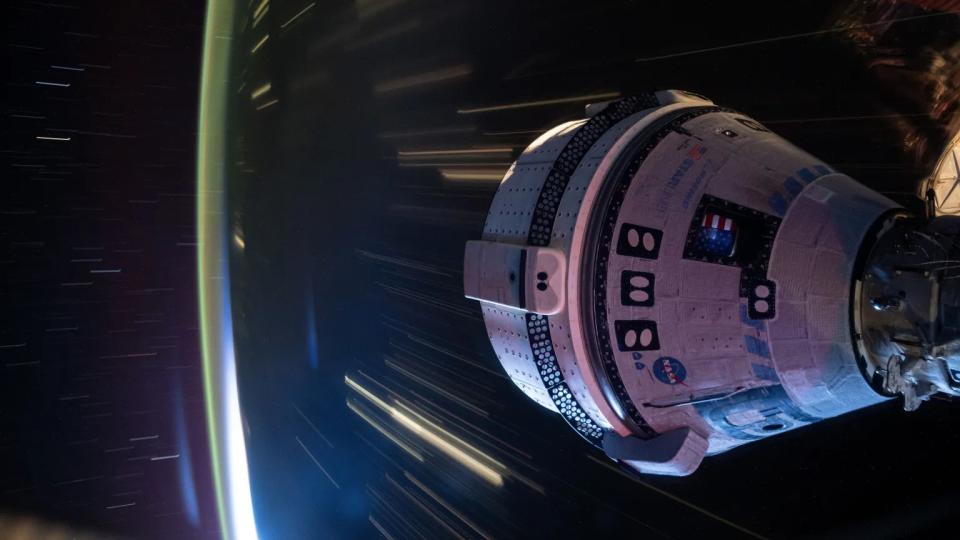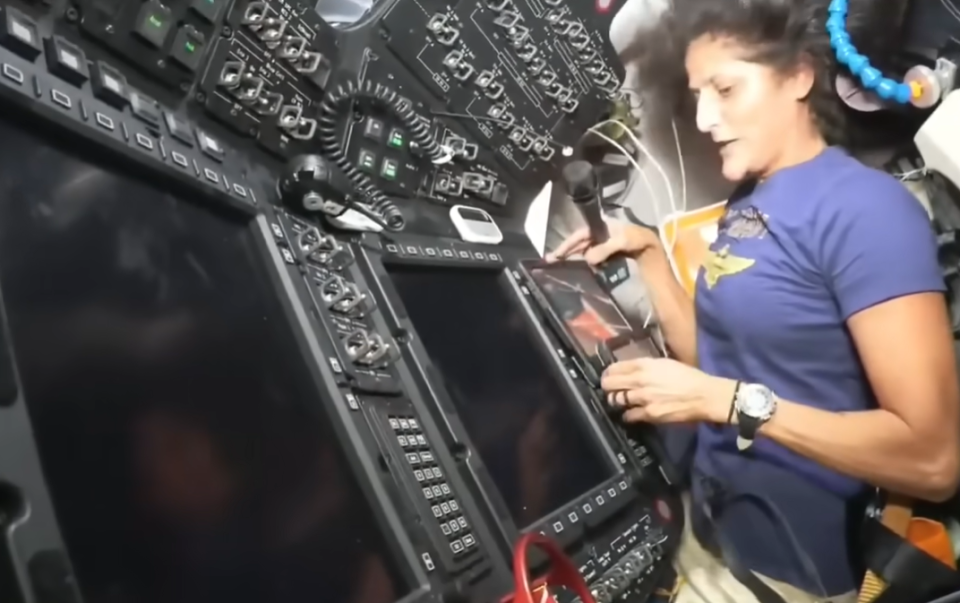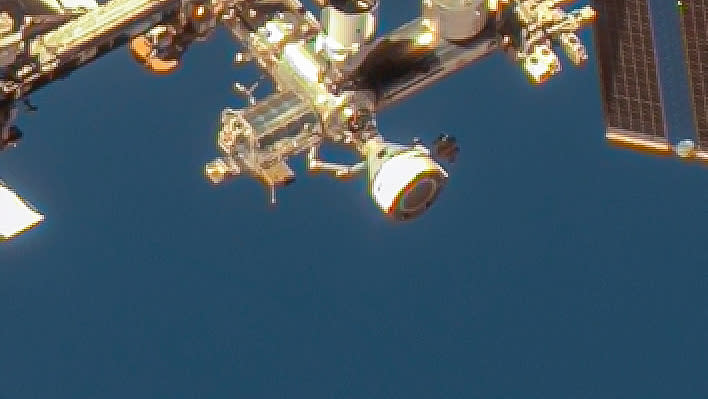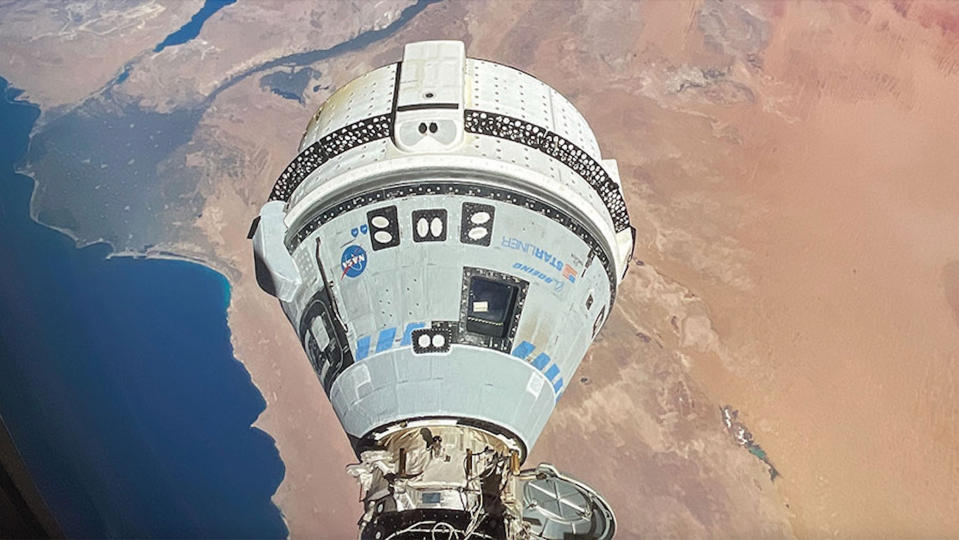50 days after launch to ISS, Boeing Starliner astronauts still have no landing date
- Oops!Something went wrong.Please try again later.
- Oops!Something went wrong.Please try again later.
When you buy through links on our articles, Future and its syndication partners may earn a commission.

Boeing's Starliner will do a "hot fire" test in orbit soon, as NASA and the company continue to probe the cause of thruster failures and a helium leak in space.
Starliner will conduct the test-fire of its 28-thruster reaction control system (RCS) on either Saturday (July 27) or Sunday (July 28) at the International Space Station (ISS), NASA and Boeing announced in a press conference today (July 25). Only 27 of the RCS thrusters will be used, however, as one previously was deemed unusable for the flight home.
Commands will be done from the ground, although NASA astronauts Butch Wilmore and Suni Williams — the astronauts flying on Starliner's current mission, known as Crew Flight Test (CFT) — will likely join, due to their interest as former U.S. Navy test test pilots.
"We're going to fire all those thrusters to a number of pulses, just to make sure before we undock, that whole system performs the way we expected and the way it did last time we checked it," Steve Stich, manager of NASA's Commercial Crew Program, told reporters in a livestreamed press conference.
"We'll also get a chance to look at the helium system," he added. "It's been six weeks since we last checked that helium system; that was on June 15. So we'll pressurize manifold by manifold, and then hot-fire the thrusters, and then we'll get a chance to look at the helium leak rates and verify that the system is stable."
CFT had been initially manifested to last about 10 days after launching on June 5, but faced thruster problems and helium leaks before safely docking with the ISS the next day. So the mission has been indefinitely extended while engineers troubleshoot the problem.
Related: When will Starliner come home? Boeing and NASA still don't know
Following ground tests at the White Sands Test Facility in New Mexico in early July, engineers now have more insight as to what happened during the difficult docking.
For example, an Aerojet Rocketdyne test MR-104J test thruster similar to those aboard Starliner, which had been in storage for three years prior to the recent ground work, experienced "severe degradation" in its valve system from nitrogen dioxide vapor; propellant flow was restricted due to bulging in a seal, Stich said. Engineers also found Teflon stuck in a downstream filter, suggesting erosion in a seal due to "bubbling" under high temperature.
The behavior of Starliner RCS thrusters in orbit seems to match what is being observed on the ground, Stich noted. The thruster type, he told Space.com during the press conference, "has heritage" from other spaceflight programs at Aerojet (an L3Harris company), but was modified for Starliner's service module, where the RCS thrusters and propulsion system are housed.

"I think what we are now starting to understand much better on this mission — and we would not have understood this by just staying on the ground and doing more analysis and test — is we understand the integrated effects between how the guidance, navigation and control system [and] the flight control system during rendezvous is commanding the thrusters to fire," Stich said.
A surrounding "doghouse" around each RCS thruster group insulates and protects the thrusters from the cold temperatures of space. (There are four doghouses on the service module in total.) What CFT has shown is that a number of RCS thruster pulses in a short time, on top of firings with the orbital maneuvering and attitude control system (OMAC), causes RCS thruster temperatures to increase more than expected.
Stich said that it's possible the problem could be addressed not by a design change, but by changing the ways in which the thrusters are used in flight (such as firing them less frequently). Discussions are ongoing at the most senior agency levels, he emphasized; NASA plans an agency-level review on CFT as early as next week, and the agency's Aerospace Safety Advisory Panel will also be invited to it, he said.
Aerojet Rocketdyne has been working closely with Boeing throughout the mission, added Boeing Commercial Crew Program Manager Mark Nappi. Discussions are ongoing as to how to address the issue. New seals might be put in, for example. For the thrusters, Boeing may ask future crews to fly a different profile to the ISS or "put different thermal protection inside the doghouse," Nappi said today.

Test missions like CFT commonly face the unexpected, and Starliner was always rated to leave the ISS in case of emergency. CFT astronauts Wilmore and Williams participated in orbital troubleshooting in June before being retasked to ISS maintenance duties for what has now been a 50-day mission (and counting).
NASA also extended CFT's initial limit in space past 45 days, saying the battery performance (which initially informed the limit) was doing better than expected in orbit. In today's briefing, Stich said the mission has now been officially rated for 90 days, or to Sept. 3 (although landing timing has not yet been firmed up.)
Understanding the root causes of the thruster and helium issues in the RCS, which controls maneuvers in orbit, is important for future Starliner missions. Following CFT, the Starliner-1 mission with at least three astronauts is supposed to spend six months on the ISS no earlier than 2025.
Starliner is one of two private U.S. spacecraft that sends astronauts to the ISS, along with SpaceX's Crew Dragon. Crew Dragon, flying crews since May 2020, is based upon SpaceX's cargo Dragon that has been to space repeatedly since 2012. Starliner, as a new spacecraft, faced development challenges after its first spaceflight.

Starliner's initial ISS launch without astronauts, in December 2019, never reached its destination due to computer problems that kept the spacecraft in the wrong orbit. The follow-up uncrewed mission reached its destination, but that took place in May 2022, after the COVID-19 pandemic erupted and dozens of fixes were implemented. (The 2022 docking also had thruster issues, which NASA thought it had addressed for CFT.)
CFT was delayed in 2023 after flammable tape was found in Starliner's wiring, and engineers discovered the parachutes could carry less load than expected. For months, the mission appeared on track for a May 6 launch date. But hours before liftoff, the astronauts were pulled out of the spacecraft after a vibrating valve was discovered in the United Launch Alliance (ULA) Atlas V rocket.
Related: 'It's so complicated:' Boeing Starliner teams diagnosing helium leak ahead of astronaut launch
Starliner stayed grounded for a month as ULA replaced the valve, and after a tiny helium leak was discovered in one RCS thruster. Extensive testing and modeling on the ground found no anticipated problems for CFT, but the analysis uncovered a vulnerability: Under certain circumstances, if enough RCS thrusters failed in adjacent doghouses, one reentry option could be affected. Following engineering and simulator work, NASA and Boeing certified a new reentry mode requiring fewer RCS thrusters to fire at a time.
CFT launched on June 5, but only after facing down another late-countdown scrub due to a ground equipment fault affecting Atlas V. Aside from experiencing issues with the docking, NASA and Boeing have emphasized that Starliner's stay in space has been uneventful and the spacecraft is performing well. And as former U.S. Navy test pilots, both Williams and Wilmore are used to long deployments and developmental programs.
RELATED STORIES:
— Starliner: Boeing's next-generation spaceship for astronauts
— Boeing Starliner 1st astronaut flight: Live updates
Starliner and SpaceX each received billions of dollars to carry astronauts under a contract with NASA's Commercial Crew Program in 2014. Following a test astronaut flight that launched in May 2020, SpaceX has now sent 11 crews to the ISS: eight on behalf of NASA, and three shorter-term ones for Axiom Space.
SpaceX missions are grounded for the time being due to a problem with the second stage of the Falcon 9 rocket encountered during a Starlink satellite launch earlier this month. The Falcon 9 completed a static fire last night, but the Federal Aviation Administration (FAA) has not yet responded to SpaceX's request to refly missions under a public safety determination; SpaceX argues that no risk was posed to the public during the launch, as only the rocket's second stage (in space) was affected.
For now, SpaceX is expected to launch two ISS missions in August, pending FAA approval and NASA's independent review: Northrop Grumman's Cygnus cargo spacecraft, and Crew-9's four astronauts aboard Crew Dragon.

